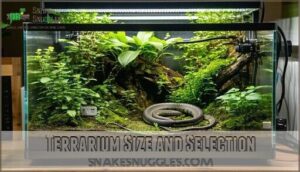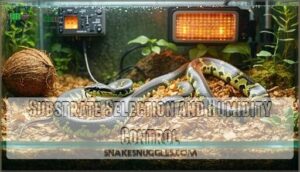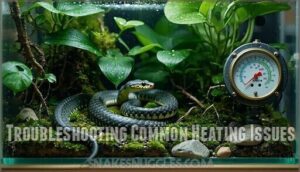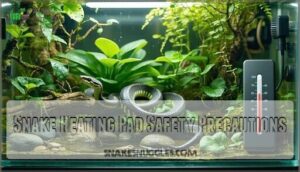This site is supported by our readers. We may earn a commission, at no cost to you, if you purchase through links.

Ball pythons need warmer ambient temperatures around 78-80°F, while corn snakes thrive at 75-78°F, and you can’t just guess—precision matters when your pet’s life depends on proper thermoregulation.
You’ll want an under-tank heat mat that covers one-third of your terrarium’s base, creating that essential thermal gradient from a 88-95°F basking spot to a 75-80°F cool zone.
The secret lies in understanding wattage requirements, thermostat compatibility, and safety features that prevent dangerous overheating situations.
Table Of Contents
- Key Takeaways
- Choosing The Right Heating Pad
- Top 5 Heating Pads for Snakes
- Setting Up a Snake Enclosure
- Heating and Lighting Cycles for Snakes
- Troubleshooting Common Heating Issues
- Snake Heating Pad Safety Precautions
- Creating a Comfortable Environment
- Frequently Asked Questions (FAQs)
- Should I use a snake heating pad?
- What is the best heating pad for snake enclosures?
- How do snake heating pads work?
- What are the dimensions of the snake heating pad?
- What are the best under tank snake heating pads?
- Do Reptiles need heating pads?
- What should my snakes heating pad be at?
- Do heat pads work for snakes?
- What is the best heat source for a snake enclosure?
- Where to place a heat mat for a snake?
- Conclusion
Key Takeaways
- You’ll need precise temperature control – Use a digital thermostat to maintain your snake’s species-specific requirements, with basking spots at 88-95°F and cool zones at 75-80°F for proper thermoregulation.
- Position your heating pad correctly – Place the UTH under one-third of your tank’s base to create essential thermal gradients that support digestion and natural behaviors.
- Choose quality equipment with safety features – Look for UL-listed heating pads with overheat protection, thermal fuses, and thermostat compatibility to prevent dangerous temperature spikes.
- Match wattage and size to your setup – Select heating pads that cover no more than half your enclosure’s floor space and match the wattage requirements for your tank size and room temperature.
Choosing The Right Heating Pad
Selecting the right heating pad for your snake isn’t just about picking the first one you see—it’s about understanding your specific species’ needs and matching them with the right equipment.
You’ll need to take into account factors like your snake’s natural habitat, enclosure size, and whether you want a basic pad or one with advanced temperature controls.
Understanding Snake Temperature Requirements
Since snakes are ectothermic, they can’t generate their own heat like you do.
Since snakes rely entirely on external heat sources, your heating pad becomes their personal thermostat for survival
Your snake needs a basking spot around 88-95°F and a cooler zone at 75-80°F.
Species variation matters—ball pythons prefer higher ambient temperatures than corn snakes.
This thermal gradient supports proper digestion and natural basking behavior, keeping your scaly friend healthy and active.
Factors to Consider When Selecting a Heating Pad
Now that you understand your snake’s temperature needs, selecting the right heating pad involves several key factors. Wattage Needs depend on your tank size and room temperature. Size Matters – choose pads covering one-third of your terrarium’s base.
Consider Pad Material for durability and Safety Features like thermal fuses. Most importantly, make certain Thermostat Compatibility for precise control.
Key selection factors:
- Power requirements – Match wattage to your specific setup
- Dimensions – Proper sizing creates ideal thermal gradients
- Built-in protection – Look for automatic shut-off features
- Quality construction – Durable materials prevent costly replacements
- Temperature precision – Thermostat compatibility guarantees your snake’s safety
Types of Heating Pads for Snakes
When choosing between under tank heater options, you’ll find several types that cater to different needs and setups.
| Type | Best For | Key Benefits |
|---|---|---|
| Under Tank Heat Mats | Most snake species, beginners | Direct belly heat, aids digestion, easy installation |
| Heat Tape | Rack systems, multiple enclosures | Flexible placement, even coverage, cost-effective |
| Radiant Heat Panels | Large terrariums, sensitive species | Mimics natural sunlight, gentle infrared warmth |
| Substrate Heat Cables | Custom vivariums, planted setups | Creative placement, low energy use, adjustable zones |
| Ceramic Heat Emitters | Nighttime heating, ambient warmth | No light disruption, consistent temperatures |
UTH vs. heat tape often comes down to your setup size. Standard reptile heat mat units work great for single enclosures, while heat tape excels in commercial breeding operations.
Infrared bulbs and ceramic emitters provide ambient heating but shouldn’t replace belly heat. Heat cable benefits include energy efficiency and design flexibility for elaborate habitats.
However, remember that heat mats may struggle to heat enclosure air.
Top 5 Heating Pads for Snakes
Now that you’ve learned the essentials, it’s time to explore the best heating pads available for your snake’s comfort and health.
We’ve tested and reviewed the top 5 options that deliver reliable performance, safety features, and excellent temperature control for various enclosure sizes.
1. Digital Heat Mat Thermostat Controller
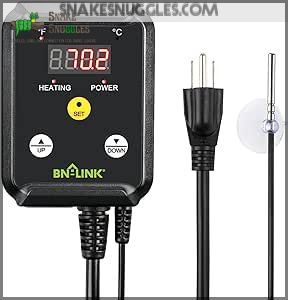
When precision matters most, the BN-LINK Digital Heat Mat Thermostat Controller stands out as a game-changer for snake keepers.
Game-changing precision meets effortless control for the modern snake keeper
This controller maintains temperatures within ±1°F accuracy, dramatically reducing the risk of overheating injuries by up to 80% compared to unregulated mats.
The three-button interface makes temperature adjustments effortless, while the bright LED display shows both current and target temperatures clearly.
With its 4.92-foot sensor probe and temperature range from 40–108°F, you’ll cover virtually any snake species’ needs.
Safety features include overheat protection and fail-safe memory that retains settings during power outages.
At around $25-50, this ETL-listed controller pays for itself within 6-12 months through reduced energy costs while keeping your serpent friend comfortable and secure.
Best For: Snake keepers and reptile enthusiasts who need precise temperature control for heating mats in terrariums and enclosures.
- Maintains temperatures within ±1°F accuracy with overheat protection and fail-safe memory during power outages
- Simple three-button interface with bright LED display showing both current and target temperatures
- Energy-efficient operation reduces electricity costs by up to 45% monthly while extending heating pad lifespan
- ±2°F temperature variance makes it unsuitable for precise incubation applications
- Requires careful probe placement to avoid overheating or equipment damage
- Limited to 1000W maximum loading capacity, which may restrict use with larger heating systems
2. Reptile Heating Pad With Temperature Control
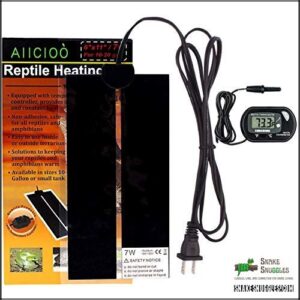
The 8" x 6" reptile heating pad with temperature control delivers reliable warmth for your snake’s health.
This 7-watt unit reaches up to 93.6°F, perfect for creating proper thermal gradients.
You’ll appreciate the built-in overheat protection that prevents dangerous temperature spikes—no accidental snake barbecue here!
The adjustable thermostat lets you dial in species-specific temperatures with precision.
Since it lacks adhesive backing, secure it with metal HVAC tape for stable placement.
The PVC construction resists moisture while the temperature controller provides dual safety protection.
Though some units may fail early, this pad works well for small enclosures and localized heating.
Pair it with an external thermometer to monitor temperatures accurately and guarantee your snake stays comfortable year-round.
Best For: Small reptile owners needing precise temperature control for ground-dwelling species like leopard geckos, ball pythons, and amphibians in tanks up to 20 gallons.
- Mixed durability reports with some units failing within two weeks of use
- Lacks adhesive backing requiring separate mounting hardware like HVAC tape for stability
- Limited heating capacity unsuitable for larger enclosures or whole-tank warming needs
- Built-in temperature controller with overheat protection prevents dangerous temperature spikes
- Flexible adhesive-free design allows placement under or inside tanks with secure mounting options
- Energy-efficient 7-watt operation reaches optimal temperatures (up to 93.6°F) for most small reptiles
3. Zilla Terrarium Heat Mat Large 50-60 Gallon
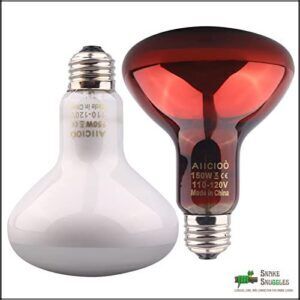
For your large snake setup, the Zilla Terrarium Heat Mat Large delivers steady 24-watt heating across 50-60 gallon terrariums.
This under-tank heater creates ideal 100°F surface temperatures, perfect for ball pythons and corn snakes.
The adhesive backing sticks securely to glass, though you’ll definitely need a thermostat for safety.
While most users love its reliability over three years, some report weakening adhesive after cleaning.
It’s energy-efficient and won’t disrupt your snake’s sleep cycle.
Best For: Large snake owners with 50-60 gallon terrariums who need reliable under-tank heating for terrestrial species like ball pythons and corn snakes.
- Delivers consistent 100°F surface temperatures with energy-efficient 24-watt operation that won’t disrupt sleep cycles
- Easy 10-minute installation with strong adhesive backing that secures to glass surfaces
- Excellent longevity with 3 year average lifespan and high user satisfaction rates
- Requires separate thermostat purchase for safe temperature control, adding to total cost
- Adhesive backing may weaken after cleaning or repositioning, requiring occasional maintenance
- Performance decreases significantly when used with plastic or wooden enclosures versus glass
4. Zoo Med ReptiTherm Under Tank Heaters
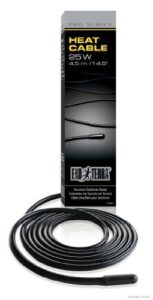
Consistency meets reliability with Zoo Med’s ReptiTherm Under Tank Heater, a time-tested favorite among snake keepers.
This UL-approved heater sticks directly to your terrarium’s glass bottom, delivering steady warmth that’s perfect for belly heat.
You’ll find sizes for 10-gallon setups all the way up to 50+ gallon enclosures, with wattages ranging from 8 to 24 watts.
The adhesive backing creates a secure bond, though removing it later can be tricky.
While it runs 24/7 without breaking a sweat, you absolutely need a separate thermostat – this heater doesn’t regulate itself.
Pro tip: Use the included rubber feet to elevate your tank slightly, preventing heat buildup underneath and extending the pad’s lifespan.
Best For: Snake owners seeking a reliable, affordable baseline heating solution for glass terrariums who plan to use it with a separate thermostat for temperature control.
- Requires separate thermostat purchase for safe operation as the heater lacks built-in temperature regulation
- Extremely strong adhesive makes removal difficult or impossible without risking glass damage to the terrarium
- Limited to glass enclosures only, with potential fire risks if used on plastic or wooden terrarium materials
- UL-approved safety certification with strong adhesive backing that creates secure, long-lasting attachment to glass terrariums
- Available in multiple sizes (10-50 gallon capacity) with low energy consumption (8-24 watts) for cost-effective 24/7 operation
- Proven track record with thousands of positive reviews citing 2 years of consistent heating performance when properly installed
5. Fluker’s Reptile Heat Mat Medium
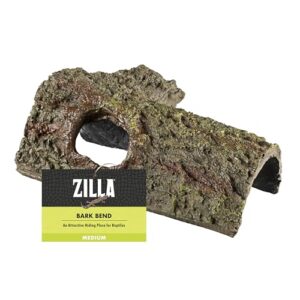
Building warmth for your snake doesn’t have to break the bank, and Fluker’s Reptile Heat Mat Medium proves this point perfectly. This 11" x 11" heating solution delivers consistent surface temperatures between 90-100°F for enclosures up to 20 gallons – think of it as a cozy electric blanket for your scaly friend.
You’ll appreciate the waterproof construction and UL-listed safety features that protect against humidity and overheating mishaps. The adhesive backing sticks firmly under your terrarium, creating that essential thermal gradient snakes need to regulate their body temperature naturally.
To prevent burns, it’s important to avoid direct contact with the heating pad. While it’s not winning any beauty contests, this heat mat gets the job done reliably.
Users report solid performance for years without failure, making it a smart choice for budget-conscious snake keepers. Just remember to pair it with a thermostat controller – your snake’s safety depends on precise temperature management, and this mat works beautifully with standard temperature controllers.
Best For: Budget-conscious reptile owners with small to medium snakes who need reliable, consistent heating for enclosures up to 20 gallons.
- Requires separate thermostat controller purchase for safe temperature regulation, adding to total cost
- Limited to smaller enclosures (10-20 gallons), making it unsuitable for larger reptiles or tanks
- Basic adhesive backing may not provide the most secure long-term mounting compared to more advanced systems
- Delivers consistent 90-100°F surface temperatures with reliable performance over multiple years
- UL-listed safety features and waterproof construction protect against overheating and humidity damage
- Low energy consumption under 10 watts keeps utility costs minimal while providing effective heating
Setting Up a Snake Enclosure
Once you’ve chosen your heating pad, creating the perfect snake habitat requires careful attention to four key setup elements.
You’ll need to balance enclosure size, establish proper temperature zones, position your heat source correctly, and select the right substrate while managing humidity levels.
This process involves considering multiple factors to ensure a suitable environment for your snake, including establishing proper temperature zones.
Terrarium Size and Selection
With your snake heating pad selected, choosing the right terrarium becomes your next priority. Your snake’s home isn’t just about looks—it’s about providing proper enclosure dimensions that match your pet’s species needs.
For adult snakes, follow the 1.5x length rule: your snake enclosure should be at least one and a half times your snake’s body length. A 4×2×2 foot terrarium works well for most adult ball pythons, while corn snakes appreciate the extra enrichment space for exploration.
Consider material safety when selecting between glass and wooden terrariums. Glass offers visibility and humidity control, while wood provides superior insulation for your under tank heater and reptile heat mat. Many owners find that front opening terrariums offer easy access and secure enclosures.
Budget considerations matter too—larger terrariums cost more initially but offer better temperature gradients and reduce upgrade needs as your snake grows. Remember, hatchlings feel more secure in smaller spaces, so you don’t need adult-sized housing immediately.
Creating a Thermal Gradient
Once your tank’s ready, think of creating zones like nature intended. You’ll need hot and cool areas, not just uniform heat throughout your snake enclosure heat.
Temperature gradient success comes down to precision:
- Basking spot: Position your under tank heater under one-third of the tank for a proper warm zone
- Cool zone: Leave the opposite end unheated, creating that 8°F temperature difference your snake craves
- Species needs: Research your snake’s ideal snake temperature—Ball Pythons need 96°F basking, while Corn Snakes prefer 85°F
- Gradient depth: Make certain your snake heating pad creates consistent warmth without hot spots that could burn
Temperature monitoring becomes your best friend here. Place thermometers at both ends to track your gradient’s effectiveness.
Placing The Heat Pad for Optimal Results
Now you’re ready for proper heat pad placement in your snake enclosure.
Position your UTH under one-third of the tank’s bottom, creating the perfect gradient creation zone.
This external vs internal approach keeps your snake safe while delivering consistent warmth.
Consider proper UTH products for ideal setup.
Choose the right pad size – never go bigger than half the enclosure floor.
Always pair with thermostat usage for temperature control and peace of mind.
Substrate Selection and Humidity Control
Your substrate types directly impact humidity levels and your snake’s comfort.
Coconut coir retains moisture well, while cypress mulch prevents mold prevention issues.
Aspen shavings work great for burrowing needs.
Mix substrates if needed – deeper layers help maintain proper reptile humidity.
Monitor snake enclosure humidity regularly, especially during shedding aid periods when snakes need extra moisture.
Heating and Lighting Cycles for Snakes
You’ll need to establish proper heating and lighting cycles that match your snake’s natural habitat patterns.
Creating automated day/night temperature fluctuations helps maintain your pet’s biological rhythms and supports healthy digestion, activity levels, and seasonal behaviors like brumation.
Mimicking Natural Day/Night Cycles
Most reptile keepers know that Temperature Fluctuation throughout the day helps maintain your snake’s Circadian Rhythm. Here’s how to create proper snake daynight cycle patterns:
- Set Light Spectrum to 12-14 hours daily, adjusting for Seasonal Variation
- Use your snake heating pad with temperature control to drop snake tank temperature 5-8°F at night
- Monitor for Brumation Effects during winter months when natural cycles slow
This mimics nature’s rhythm, keeping your snake healthy year-round.
Automating Heating and Lighting Cycles
Taking control of temperature means embracing smart thermostats and programmable timers for effortless automation.
These digital temperature controllers maintain your snake’s day-night cycle while you sleep.
Remote monitoring lets you adjust seasonal temperatures from anywhere.
Set light dimmers for gradual shifts, and your reptile thermostat handles the rest—creating perfect conditions without constant babysitting.
Adjusting Seasonal Cycles for Brumation or Hibernation
Automating cycles work great, but your snake’s seasonal needs require different adjustments.
Brumation triggers naturally occur when snake enclosure temperature drops and daylight shortens.
Here’s your game plan:
- Gradually lower your snake habitat temperature by 4-8°F over several weeks – sudden temperature drops stress your scaly friend
- Reduce photoperiod to 8 hours using LED timers while monitoring snake temperature closely
- Stop feeding 2 weeks before temperature changes begin – feeding cessation prevents digestive issues during snake cooling
- Maintain proper hydration importance with 50-70% humidity throughout the shedding cycle and brumation period
Troubleshooting Common Heating Issues
Even with the best heating pad setup, you’ll occasionally run into temperature problems that can stress your snake or affect its health.
Common issues like insufficient heating, overheating, uneven temperature gradients, and humidity imbalances are easier to fix than you might think, with temperature problems being a key concern.
Insufficient Heating and Its Effects
When your snake’s heating system fails, you’ll notice sluggish behavior and digestion problems immediately.
Insufficient warmth triggers stress indicators like poor appetite, shedding issues, and weakened immunity.
Your snake temperature directly affects snake health – without proper snake digestion, food sits unprocessed for days.
A quality snake heating pad or best snake heater prevents these dangerous complications and keeps your reptile thriving.
Overheating and Its Risks
While insufficient heating leaves snakes sluggish, overheating creates equally dangerous problems that can kill your pet.
Watch for excessive hiding, mouth breathing, or restless pacing—your snake’s telling you it’s too hot.
Here’s what puts your snake at risk:
- Thermostat failure can send temperatures soaring beyond safe limits
- Poor pad placement directly under hiding spots creates dangerous hot zones
- Species sensitivity varies—ball pythons tolerate heat better than corn snakes
- Fire hazard increases when safety features like automatic shutoff functions malfunction
Emergency response means gradually cooling the enclosure and checking your thermostat immediately.
Ensuring proper heat source selection is essential for snake wellbeing.
Maintaining a Consistent Temperature Gradient
Temperature gradients aren’t just suggestions—they’re survival essentials for your snake.
Gradient monitoring requires strategic heat source placement and proper thermostat calibration.
Position your snake heating pad under one-third of the enclosure, creating a warm-to-cool spectrum.
Regular seasonal adjustments accommodate species variation in snake temperature control, ensuring your heating pad placement maintains ideal temperature gradient year-round.
Humidity Control and Its Importance
Beyond temperature control, your terrarium’s humidity levels directly impact your snake’s health and comfort.
Here’s what proper humidity management prevents:
- Shedding Issues – Low humidity causes stuck shed that can restrict blood flow
- Respiratory Infections – Excessive moisture creates breeding grounds for harmful bacteria
- Hydration Needs – Balanced humidity supports your reptile’s natural moisture absorption
Monitor with hygrometers and adjust misting techniques alongside your thermostat settings.
Snake Heating Pad Safety Precautions
When setting up your snake’s heating pad, safety isn’t just important—it’s essential for your pet’s health and your home’s security.
You’ll need to follow specific precautions to prevent burns, fires, and equipment failures that could harm both you and your snake, ensuring essential measures are taken for protection.
Avoiding Burns and Overheating
Preventing burns requires vigilant temperature monitoring and proper thermostat calibration.
Safe wattage selection and strategic pad placement create reliable heating without fire hazards.
Your snake heating pad needs consistent oversight to maintain safe snake heating and prevent dangerous overheating.
Essential snake tank safety measures include:
- Installing backup heat systems for equipment failures
- Monitoring substrate thickness over heating elements
- Checking for equipment malfunctions during weekly inspections
Safe Placement of The Heat Pad
Proper heat pad placement keeps your snake safe from burns and fire hazards.
Install the snake heating pad outside your tank, covering one-third of the bottom area.
Never overlap pads or place them inside plastic enclosures.
Route cables away from your pet’s reach and use a thermostat for precise temperature control and safe snake heating.
Monitoring Temperature Levels
Once you’ve got your heat pad properly positioned, keeping tabs on actual temperatures becomes your lifeline.
Digital thermostats with built-in temperature logging give you consistent readings, while infrared thermometers let you spot-check your thermal gradient instantly.
Smart thermometer placement on both warm and cool sides guarantees your reptile temperature requirements stay dialed in perfectly through your temperature gauge monitoring.
Using a Thermostat for Temperature Control
A thermostat controller acts as your heating system’s brain, preventing dangerous temperature spikes that could harm your snake.
This reptile heating solution automatically adjusts heat output, maintaining the perfect temperature gradient your cold-blooded friend needs.
Without proper thermal management, you’re gambling with your pet’s health.
The use of a thermostat device is vital for maintaining ideal temperatures.
Here’s how precision heating works:
- Temperature Regulation – Set exact basking temperatures and the thermostat maintains them within 1-2°F
- Heat Control Safety – Automatically shuts off heating when temperatures exceed safe limits
- Thermostat Settings – Program day/night cycles for natural temperature fluctuations
Creating a Comfortable Environment
Once you’ve got your heating pad properly installed and temperature controlled, you’ll want to create a complete habitat that makes your snake feel at home.
A comfortable environment goes beyond just heat – it includes hiding spots, enrichment, proper humidity, and careful observation of your snake’s behavior patterns.
Providing Hiding Spots and Enrichment
Beyond your snake heating pad setup, smart hiding places create security and reduce stress. Your slithery friend needs both warm and cool retreats to thermoregulate properly while feeling safe from perceived threats.
- Multiple hide types: Provide at least two hiding places—one on the warm side, one on the cool side
- Natural materials: Use cork bark, hollow logs, or rock caves for authentic environmental enrichment
- Size matters: Choose hides where your snake can curl up completely while touching all sides
- Visual stimulation: Add live or artificial plants for sensory experience and natural snake toys
Providing a stimulating environment involves understanding cognitive enrichment techniques to promote mental and physical well-being.
Creating a Snake Jungle Gym
Transform your snake’s home into an adventure playground with strategic Snake Climbing structures.
Install sturdy branches and artificial vines for Branch Placement that creates vertical exploration opportunities.
Add Hide Boxes at different levels and weave in Tunnel Systems through your Jungle Decor.
These enrichment features boost activity by 30% while supporting natural behaviors.
Choose washable, non-porous materials positioned away from your snake heating pad to prevent overheating accidents.
Maintaining Proper Humidity and Temperature Levels
Perfect temperature control and humidity levels create your snake’s ideal habitat.
Monitor your thermal gradient using reliable thermostats—basking spots should hit species-specific temps while cool zones stay 8°F lower.
Maintain humidity through substrate selection and water bowls.
Your reptile heating pad provides consistent warmth, but pair it with hygrometers for precision monitoring.
Observing and Responding to Snake Behavior
Your snake’s body language reveals everything about their comfort level.
Watch for these key behavioral patterns to guarantee your snake heating pad creates the perfect environment:
- Feeding cues: Active tongue-flicking signals hunger and proper temperatures
- Stress signs: Erratic movement or hiding indicates temperature issues
- Comfort indicators: Regular basking shows ideal reptile heating solutions
Frequently Asked Questions (FAQs)
Should I use a snake heating pad?
Like a warm blanket on a cold night, you’ll definitely need a heating pad for your snake’s health.
Snakes can’t regulate their body temperature alone, so they rely on external heat sources for proper digestion, metabolism, and overall wellbeing in captivity.
They need this external heat for their overall wellbeing, which is crucial when keeping them in captivity.
What is the best heating pad for snake enclosures?
You’ll want the Zoo Med ReptiTherm Under Tank Heater as your top choice.
It’s Amazon’s #1 bestseller with nearly 600 reviews, offering reliable adhesive placement and consistent heat distribution for safe temperature regulation.
How do snake heating pads work?
Heating pads create warmth through electrical elements that convert electricity into heat energy.
You’ll place them under your snake’s enclosure where they radiate gentle, consistent heat upward through the tank bottom, mimicking natural ground warmth snakes seek in the wild, providing a gentle heat.
What are the dimensions of the snake heating pad?
You’ll find snake heating pads come in various sizes to fit different enclosures. Popular dimensions include 4″ x 7″ for small tanks, 11″ x 17″ for medium setups, and 20″ x 20″ for larger terrariums.
What are the best under tank snake heating pads?
You’ll find Zoo Med ReptiTherm Under Tank Heater tops the list as Amazon’s #1 bestseller. Century T7 Digital Heat Mat Thermostat Controller pairs perfectly for precise temperature control at just $
Do Reptiles need heating pads?
Yes, reptiles absolutely need heating pads since they’re cold-blooded and can’t regulate their body temperature internally.
You’ll need external heat sources to keep them healthy, active, and able to digest food properly.
What should my snakes heating pad be at?
Your snake’s heating pad temperature depends on species, but most thrive with basking spots at 85-96°F and cool sides around 70-78°F.
You’ll want that perfect gradient for proper digestion.
Do heat pads work for snakes?
Under-tank heat pads are actually the gold standard for snake heating.
They’re safer than heat lamps, maintain proper humidity levels, and create essential temperature gradients that snakes need for thermoregulation and digestion.
What is the best heat source for a snake enclosure?
Under-tank heating pads (UTH) are your best bet for snake enclosures.
They’re safer than overhead heat, maintain humidity better, and create natural temperature gradients your snake needs for proper thermoregulation and digestion.
Your snake needs these conditions for proper thermoregulation and digestion to occur efficiently.
Where to place a heat mat for a snake?
Place your heat mat outside the enclosure, underneath one-third to one-half of the tank’s base.
This creates a temperature gradient—warm basking area and cooler retreat zone—essential for your snake’s thermoregulation needs.
Conclusion
Despite seeming overwhelming at first, choosing the right heating pad for your snake doesn’t have to be complicated when you follow this buyers guide heating pads for snakes approach.
You’ve learned that proper temperature control starts with understanding your species’ specific needs and selecting quality equipment with reliable thermostats.
Remember, your snake’s health depends on consistent temperatures, so invest in proven brands and always monitor your setup regularly to guarantee the best conditions.
- https://www.zenhabitats.com/blogs/reptile-care-sheets-resources/overhead-heating-vs-under-tank-heating-for-leopard-geckos-pros-and-cons
- https://www.lllreptile.com/catalog/16-heat-pads-heat-panels-heat-cable-and-rocks
- https://www.dendroboard.com/threads/under-tank-heating-pad-a-good-idea.363125/
- https://www.reddit.com/r/snakes/comments/13j7szj/heat_lamps_or_heat_mats_which_are_better/
- https://www.thebiodude.com/blogs/reptile-and-amphibian-lighting-faqs-and-help/here-s-why-you-shouldn-t-be-using-a-heat-mat-for-your-reptile

